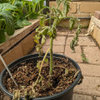Hi,
I am writing to get any help I can to a problem that has beset all of my tomato plants (Better Boy, Silvery Fir Tree, Delicious, Early Girl, Celebrity, and Brandywine). The leaves have begun to curl on all of the plants and I cannot figure out why. I first noticed the problem a couple of weeks ago and sprayed with Daconil; it has not helped. I am horrified that I may lose all of my tomato plants! I don't think it is a watering problem as the plants have had plenty of water the past few weeks and the problem continues. I don't think the problem is insect-related, either, as I don't see any real infestation. I could be wrong, though. If anyone can help, I would be so grateful.
{{gwi:1300334}}
{{gwi:1300335}}
{{gwi:1300336}}
{{gwi:1300337}}
{{gwi:1300338}}








nanelle_gw (usda 9/Sunset 14)
nctom
Related Professionals
Bellflower Landscape Architects & Landscape Designers · Concord Landscape Contractors · Surprise Landscape Contractors · Belvedere Park Landscape Contractors · Burlington Landscape Contractors · Choctaw Landscape Contractors · Mastic Beach Landscape Contractors · North Canton Landscape Contractors · Palatine Landscape Contractors · Post Falls Landscape Contractors · Soddy Daisy Landscape Contractors · Vashon Landscape Contractors · Woodbury Landscape Contractors · Aliso Viejo Siding & Exteriors · La Puente Outdoor Lighting & Audio Visual SystemsJarrod_KingOriginal Author
carolyn137
Jarrod_KingOriginal Author
Jarrod_KingOriginal Author
carolyn137
Colorado_west
thaicat
Colorado_west
travisheaton
foodscaper
enchantedme
organic_jeannie
enchantedme